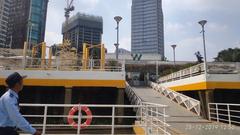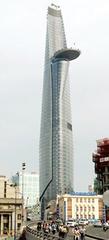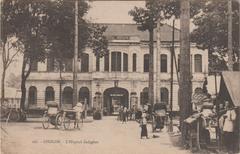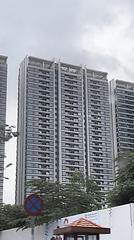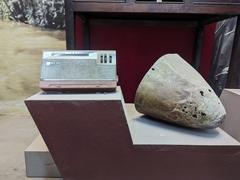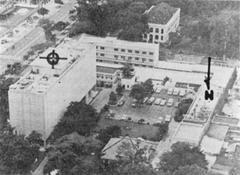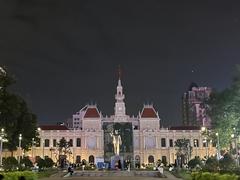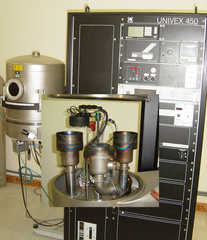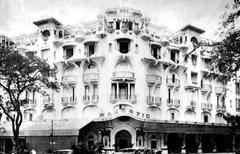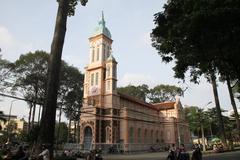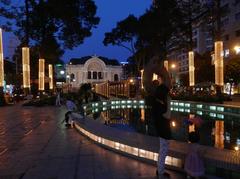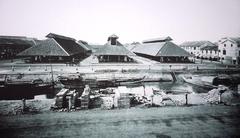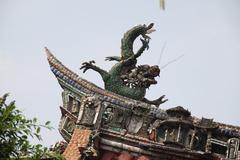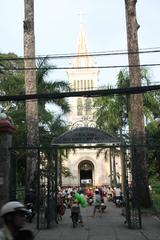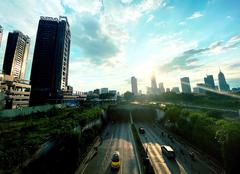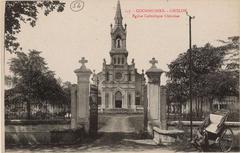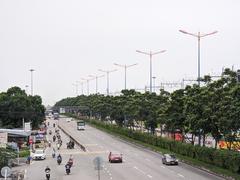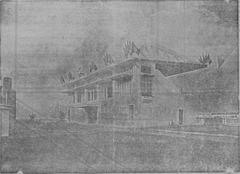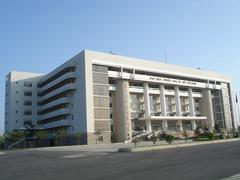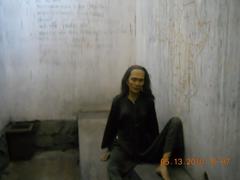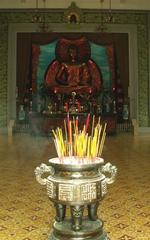
Jade Emperor Pagoda: Visiting Hours, Tickets & Complete Travel Guide to Ho Chi Minh City’s Historical Site
Date: 04/07/2025
Introduction
Nestled in the vibrant heart of Ho Chi Minh City, the Jade Emperor Pagoda (Chùa Ngọc Hoàng or Phước Hải Tự) is a profound testament to Vietnam’s rich cultural heritage and religious syncretism. Established between 1892 and 1909 by Cantonese Chinese immigrants, the temple was dedicated to the Jade Emperor (Ngọc Hoàng), the supreme Taoist deity. With its striking southern Chinese architecture, intricate woodwork, and mythological roof sculptures, the pagoda draws visitors into a unique spiritual and artistic experience that harmoniously blends Taoism, Mahayana Buddhism, and local folklore (Vietnam Tourism; Lonely Planet).
More than an architectural marvel, the Jade Emperor Pagoda remains a vibrant religious sanctuary and cultural hub for both the Chinese-Vietnamese community and visitors worldwide. Surviving French colonial rule, the Vietnam War, and modern urban transformations, it stands as a living symbol of multicultural harmony and spiritual devotion. The temple hosts diverse rituals and festivals—such as incense offerings, turtle releases symbolizing longevity, and celebrations during Lunar New Year and the Jade Emperor’s birthday—bringing its spiritual energy to life (Vietnam Online; Haivenu Vietnam).
Open daily with free admission, the pagoda welcomes all who seek cultural insight, spiritual solace, or simply the chance to admire its artistry. Its central District 1 location, near other key landmarks, makes it a highlight of any Ho Chi Minh City itinerary (Vietnam National Administration of Tourism).
Table of Contents
- Origins & Construction
- Historical Evolution & Preservation
- Religious & Cultural Significance
- Visiting Hours, Tickets & Accessibility
- Directions, Travel Tips & Nearby Attractions
- Visitor Experience & Etiquette
- Frequently Asked Questions (FAQ)
- Architectural Highlights
- Modern-Day Importance & Global Recognition
- Plan Your Visit
- Summary & Final Recommendations
- References
Origins & Construction
The Jade Emperor Pagoda was built between 1892 and 1909 by the Cantonese (Guangdong) Chinese community. Merchant and devout Buddhist Lưu Minh led its establishment, dedicating the temple to the Jade Emperor (Vietnam Tourism). The pagoda’s southern Chinese architectural style features intricate woodwork, ceramic tile decorations, and mythical roof creatures. Its red brick walls symbolize prosperity, while the main hall houses a statue of the Jade Emperor surrounded by Taoist and Buddhist deities, reflecting the region’s religious syncretism (Lonely Planet).
Historical Evolution & Preservation
Throughout the 20th century, the pagoda served as a spiritual and social hub for Ho Chi Minh City’s Chinese community, ensuring cultural continuity during French colonialism and the Vietnam War. In 1984, the government renamed it Phước Hải Tự (“Luck of the Sea Temple”) as part of a national effort to integrate Chinese religious sites. In 1994, it was recognized as a national architectural and artistic monument, ensuring ongoing preservation (Vietnam National Administration of Tourism).
Religious & Cultural Significance
Syncretic Spirituality
The Jade Emperor Pagoda exemplifies the harmonious integration of Taoism, Mahayana Buddhism, and folk beliefs. The Jade Emperor is revered as the heavenly ruler, with altars to the Goddess of Mercy (Quan Âm), the City God (Thành Hoàng), and the fertility goddess Kim Hoa Thánh Mẫu, who is especially venerated by couples hoping for children (Atlas Obscura).
Rituals & Festivals
Visitors encounter altars, incense coils, and wood carvings illustrating Taoist mythology and Buddhist sutras. The turtle pond, symbolizing longevity and good fortune, is central to ritual life, where releasing turtles is believed to bring blessings. Major festivals include Lunar New Year (Tết Nguyên Đán) and the Jade Emperor’s birthday on the 9th day of the first lunar month, both attracting large crowds and elaborate ceremonies (Vietnam Online).
Symbolic Architecture
The pagoda’s architecture is rich in symbolism, with dragons and phoenixes representing cosmic balance. Statues of generals who vanquished the Green Dragon (Yang) and White Tiger (Yin) embody Taoist duality (Wandering Carol). The Hall of the Ten Hells vividly portrays moral lessons and afterlife beliefs.
Community Role
Functioning as a cultural bridge, the pagoda preserves Chinese-Vietnamese heritage while welcoming all faiths. Community events, charitable activities, and educational programs foster cultural exchange and interfaith understanding (Vietnam Discovery).
Visiting Hours, Tickets & Accessibility
- Opening Hours: 7:00 AM – 5:00 PM daily (some sources note 8:00 AM – 5:00 PM; check ahead for holiday changes).
- Admission: Free entry; donations are appreciated to support maintenance.
- Accessibility: Partial wheelchair access (ramps at main entrance; uneven interior floors and steps may limit full access).
- Guided Tours: Available through local operators; book in advance for historical and architectural insights.
Directions, Travel Tips & Nearby Attractions
- Address: 73 Mai Thi Luu Street, District 1, Ho Chi Minh City.
- Getting There: Easily accessible by taxi, Grab, or public bus; a short ride from the city center.
- Best Visiting Times: Early morning or late afternoon to avoid crowds; festivals for cultural vibrancy.
- Dress & Etiquette: Modest attire (cover shoulders and knees), remove shoes in prayer halls, maintain respectful silence.
- Nearby Attractions: War Remnants Museum, Notre-Dame Cathedral Basilica of Saigon, Ben Thanh Market, Saigon Zoo & Botanical Gardens.
Visitor Experience & Etiquette
Upon arrival, visitors are greeted by the pagoda’s ornate pink façade and tranquil turtle pond. The main hall’s incense-filled atmosphere and intricate carvings create a mystical ambiance. Photography is generally allowed (no flash; respect signage in restricted areas). Visitors can light incense, make offerings, and even participate in turtle-release rituals.
Etiquette Tips:
- Remove hats and sunglasses inside prayer halls.
- Keep phone on silent.
- Do not touch statues or altars.
- Avoid pointing feet at religious icons.
- Ask before photographing people.
- Public displays of affection are discouraged.
Frequently Asked Questions (FAQ)
Q: What are the pagoda’s visiting hours?
A: Open daily from 7:00 AM to 5:00 PM (some sources list 8:00 AM – 5:00 PM).
Q: Is there an entrance fee?
A: No, but donations are appreciated.
Q: Are guided tours available?
A: Yes, through local operators.
Q: Is the pagoda accessible for wheelchairs?
A: Main entrance has ramps; some interior areas have steps and uneven flooring.
Q: Can tourists participate in rituals?
A: Yes, respectfully, including incense lighting and turtle release.
Q: When is the best time to visit?
A: Early mornings, late afternoons, or during festivals for the full experience.
Architectural Highlights
- Exterior: Ornate pink façade, dragons and phoenixes on roofline, stone lions at entrance, tranquil turtle pond.
- Main Hall: Jade Emperor statue flanked by guardians, red wooden columns, incense coils.
- Side Chambers: Depict cosmic justice (Chamber of Thanh Hoang) and family blessings (Room of the Twelve Mothers).
- Upper Hall: Honors Quan Âm (Goddess of Mercy) and Đạt Ma (Bodhidharma), underscoring religious syncretism.
- Materials: Rich woodcarvings, lacquered panels, calligraphy, vibrant colors (Lonely Planet).
Modern-Day Importance & Global Recognition
The Jade Emperor Pagoda continues to attract thousands of local worshippers and international tourists each year. Its spiritual significance in prayers for fertility, health, and business success is widely recognized. A major milestone was the visit by U.S. President Barack Obama in 2016, which elevated its international profile (BBC News). Preservation efforts, led by government and community support, focus on maintaining the temple’s original features for future generations (Saigoneer).
Plan Your Visit
- Prepare: Dress appropriately, bring small change for donations, and check festival schedules.
- Enhance Your Experience: Download the Audiala app for guided audio tours, maps, and up-to-date visitor information.
- Combine Attractions: Plan to visit other nearby sites for a comprehensive cultural day.
Summary & Final Recommendations
The Jade Emperor Pagoda is a living testament to Ho Chi Minh City’s multicultural spiritual heritage. Free to enter and open daily, it offers an immersive journey into Taoist and Buddhist traditions, artistic craftsmanship, and local community life. The temple’s central location, vibrant festivals, and rich symbolism make it a must-see for any visitor. Enhance your visit with guided tours, respect temple etiquette, and take advantage of travel apps for the latest updates and personalized guidance.
References
- Vietnam Tourism
- Lonely Planet
- Vietnam National Administration of Tourism
- Atlas Obscura
- Vietnam Online
- Haivenu Vietnam
- Saigoneer
- Vietnam Discovery






















